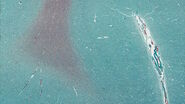Ion polishing is often the final step of sample preparation. The prerequisite is a perfect mechanical prepreparation as samples with deep surface scratches cannot be ion polished. Soft materials usually have a smeared sample surface after mechanical polishing. It is necessary to remove this smeared material before ion polishing. Otherwise the above mentioned polishing effect does not work.
Polishing of an oil shale sample
Mechanical polishing of oil shale is difficult because of the different hardness of the organic and inorganic components. The surface is often not completely flat. A final ion polishing after mechanical polishing can greatly enhance the surface quality. On the other hand, the sample surface should be as good as possible before ion polishing. Thus the combination of both steps should be the right way to achieve a good result.
Preparation Parameters
| Acceleration Voltage: | 6 kV |
| Gun corrent: | 2.2 mA |
| Sample movement: | Area mode |
| Milling angle: | 3° |
| Milling time: | 6 h |
Results
The images show an oil shale sample after mechanical polishing and after additional ion polishing. Due to the different hardness of the components of the oil shale the surface quality is not good enough for imaging. An additional ion polishing of an area about 20 mm in diameter leads to a much better surface quality. Now it is possible to observe structural details.
Polishing of nickel based superalloy
Usually sample surface is not completely free of damage after mechanical polishing. The depth of surface damage is three times than the grain size of the lapping foil. Ion polishing is a good tool to remove such damage. It can be used for SEM and TEM samples.
Preparation Parameters
| Acceleration voltage: | 7 kV |
| Gun current: | 2.6 mA |
| Sample movement: | Rotation |
| Milling angle: | 5° |
| Milling time: | 3 h |
Results
Fig. 5-6 show a Nickel based superalloy after mechanical polishing and after additional ion polishing. The sample surface has a lot of fine scratches after mechanical polishing. It was possible to remove all these scratches and to achieve a nice surface after an additional 3 hours ion polishing.











